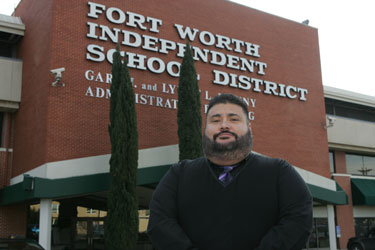“Every time we are asked to make cuts, we start at the bottom, not the top,” said Fort Worth schools trustee Carlos Vasquez. “I have asked that we start at the top, but it never happens. … We are asked instead to cut teacher assistants, the lowest paid and the most needed in the classrooms.”
Facing a budget shortfall of $31 million this fiscal year, the school district is scrambling to find ways to keep the schools open without having to lay off teachers. Nor is it going to get better anytime soon: The predicted shortfall for next year is close to $30 million; both years’ budgets are being deeply affected by state funding cutbacks that could total up to $80 million for the biennium.
 The district has offered bonuses of $1,000 to $5,000 to those who are willing to take early retirement but didn’t get enough response to stave off layoffs. Now district administrators are proposing that low-end jobs be cut first.
The district has offered bonuses of $1,000 to $5,000 to those who are willing to take early retirement but didn’t get enough response to stave off layoffs. Now district administrators are proposing that low-end jobs be cut first.
In a budget document released to the trustees last week by finance chief Hank Johnson, low-wage jobs were targeted for cuts, including 28 teacher assistants, 10 clerical posts, 74 auxiliary positions, (bus drivers, cafeteria workers, janitors), 11 counselors, and an unknown number of school monitors, who help teachers keep order in the classrooms and the hallways. Many of these positions start at minimum wage. The lowest-salaried person to face a layoff makes a little more than $6,000 a year. The highest-paid job slated to be eliminated is an assistant superintendent’s position listed at $120,000 (the current holder of the job was not named).
Trustee Ann Sutherland said that even though the finance chief’s proposal does a lot of cutting from the bottom, it is also true that 100 of the 186 at-will positions he proposes to eliminate are from central administration.
“That is a huge step forward,” she said.
At Tuesday night’s board meeting, a decision on the cuts proposed in Hank Johnson’s report was postponed. However, in separate action, school trustees approved laying off 85 employees, including some special education teachers and others whose salaries were paid by federal stimulus funds, as well as a group of teachers known as “retiree/rehires” — retired teachers who have been rehired and are drawing benefits as well as full salaries. The plan is to fill their slot with teachers whose current positions are being eliminated due to the budget cuts.
Those who will be laid off by Tuesday’s action, Sutherland said, include counselors, nurses, and temporary hires who were working under contract and who had been certified as teachers. As required under state law when a district lays off teachers who are working under contract, the trustees declared a “financial exigency.” Vasquez and trustee Juan Rangel opposed the move, and Rangel said he believes there are still places to cut without laying off teachers.
The finance chief’s proposal — even in such a tough budget year — didn’t touch the top 10 positions on Superintendent Melody Johnson’s administrative staff. According to data obtained by the Texas Tribune under a public information request, that group drew a total of more than $1.7 million in salary in 2010, higher than Austin, with a comparable enrollment, whose top 10 employees’ salaries totaled $1.4 million.
Critics of the current district leadership say the first cuts, instead, should be made at the top, from the too-numerous ranks of administrators and other headquarters personnel, some of whom receive among the highest public school district salaries in the state.
Cutting some administrative jobs and reducing salaries for others, the critics said, could save teachers’ jobs and keep the district functioning.
Vasquez said that the district administration has grown to about six times the size it was under former Superintendent Thomas Tocco, who was forced to resign in 2003, “and people thought his administration was top-heavy.”
Trustee Ann Sutherland has asked for data on the growth of the district’s nonteaching administrative employees but was told it would be too cumbersome to put together because administrative offices were scattered across the district. However, the Weekly found much of that data in the district’s own administration building directories for 2007 and 2011.
The two editions of that directory, listing all administrative departments and their employees, showed that nonteaching positions have grown from about 810 to about 860 in the last four years.
Superintendent Melody Johnson made $328,950 last year, second only to the superintendent for Beaumont public schools. She makes more than the superintendents in cities such as Dallas, Arlington, Austin, or Houston. Her deputy superintendent, Walter Dansby, made more than $207,000 — more than deputy superintendents in Arlington and Austin. Seven other Fort Worth administrators made between $142,000 and $175,000. And the six-figure salaries apparently continue deep into the administration: The district’s top 105 non-teaching employees, according to the database published online by the Tribune, pulled down a total of more than $10.7 million last year, not including perquisites such as auto allowances. That works out to an average of about $102,500 — more than any teacher in the district. Teachers make between $44,000 and $69,000, depending on longevity.
In addition to the one assistant superintendent whose job would be cut, the post of chief of elementary school leadership may not be filled when its current occupant, Robert Ray, retires at the end of this school year. He makes $147,175.
The school board is kept in the dark about most of the growth in administrative ranks, Vasquez said. Board policy is to require approval only of the hiring of assistant principals, principals, and assistant or associate superintendents. The administrative departments, with anywhere from two to 100 support staffers, are filled with jobs like administrative assistants, directors, executive directors, coordinators, specialists, analysts, and managers.
The budget information packets given to trustees last week also included cutting programs designed for at-risk students — an important factor in a district with drop-out rates estimated at 20 to 50 percent and in which 75 percent of students are deemed “economically disadvantaged” and 28 percent have limited English proficiency.
Hank Johnson’s proposal includes saving about $208,000 by ending the district’s 14-year involvement with UMOJA, an organization of mostly black men who volunteer to help keep at-risk kids in school and provide them with mentors. An “attendance control” position filled by a Tarrant County assistant district attorney, whose role is also to help keep kids in school, is on the list of cuts, saving $115,000. The truancy court would disappear as well, saving the district $675,000. And the district would cancel its $120,000 contract with Communities in Schools, an organization that helps find resources for needy kids including healthcare, after-school care, and tutoring.
Vasquez said that UMOJA has done a good job keeping at-risk black students in school and should be continued, along with the other programs listed on the chopping block. “These programs help the most vulnerable kids in our district, but I don’t think the establishment in this town cares about them,” he said.
Sutherland said she believes that public support shown at Tuesday’s meeting for UMOJA and Communities in Schools will save those programs from being cut.
Larry Shaw, head of the United Educators Association, the largest teachers’ union in the county, also said those programs should be retained. It’s true that those programs target the district’s most vulnerable kids, he said. “However, most of the kids in the district are ‘at risk.’ When the legislature cuts [funds to the Fort Worth district], it is forcing cuts in programs that are aimed at at-risk kids. There isn’t a lot of choice.”
A 10 percent pay cut by the district’s highest-salaried employees could produce almost enough to continue funding those programs — and that would be a good idea, Shaw said.
One of the fastest-growing administrative areas has been the technology department, which expanded from a staff of 59 in 2007 to 108 last year. The technology department is responsible, among other things, for making the troubled new student information software called Connects work.
“With all that growth,” Vasquez said, “this is the department we’re having the most problems with.” According to teachers, data clerks, and nurses, the program is still full of glitches that range from recording incorrect transcripts for seniors to inaccurate attendance data to an inability to correctly list students in need of immunizations for such highly contagious diseases as pertussis and measles.











